Ruth Ellen Gruber's Blog, page 10
April 6, 2012
Still Early Spring in Budapest
By Ruth Ellen Gruber
I seem to have been eating a lot this trip.... spending a lot of time at the Cafe Noe, in the 7th District Jewish quarter, and Torta, near the Danube, sampling Flodni, Matzo Apple Cake and other items... both places are run by Miklos Maloschik and Rachel Raj.
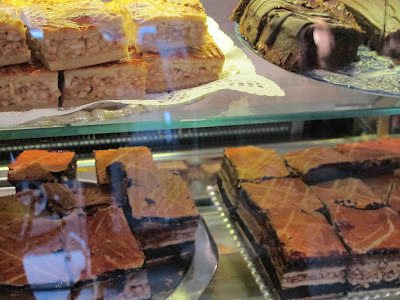 Matzo apple cake and Flodni, at Cafe Noe. Photo (c) Ruth Ellen Gruber
Matzo apple cake and Flodni, at Cafe Noe. Photo (c) Ruth Ellen Gruber
Cafe Noe is around the corner from the grand Dohany st. Synagogue (the biggest in Europe) -- last week, before the leaves started coming out, I could actually get a picture of the full complex. The section on the left houses the Jewish museum. It was built in the 1930s on the site of the hosue where Theodor Herzl was born, in a style that matches that of the synagogue, which was completed in 1859.
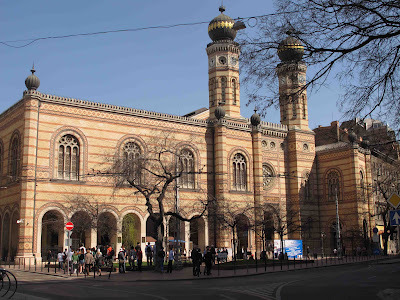 Dohany St. Synagogue. Photo (c) Ruth Ellen Gruber
Dohany St. Synagogue. Photo (c) Ruth Ellen Gruber
I seem to have been eating a lot this trip.... spending a lot of time at the Cafe Noe, in the 7th District Jewish quarter, and Torta, near the Danube, sampling Flodni, Matzo Apple Cake and other items... both places are run by Miklos Maloschik and Rachel Raj.
 Matzo apple cake and Flodni, at Cafe Noe. Photo (c) Ruth Ellen Gruber
Matzo apple cake and Flodni, at Cafe Noe. Photo (c) Ruth Ellen GruberCafe Noe is around the corner from the grand Dohany st. Synagogue (the biggest in Europe) -- last week, before the leaves started coming out, I could actually get a picture of the full complex. The section on the left houses the Jewish museum. It was built in the 1930s on the site of the hosue where Theodor Herzl was born, in a style that matches that of the synagogue, which was completed in 1859.
 Dohany St. Synagogue. Photo (c) Ruth Ellen Gruber
Dohany St. Synagogue. Photo (c) Ruth Ellen Gruber
Published on April 06, 2012 02:35
April 4, 2012
Early Spring in Budapest
By Ruth Ellen Gruber
It has been a busy visit so far in Budapest, with little time to stop and reflect (or post). Here are a few highlights..... and with luck I'll be able to add a bit more in the coming days. Today at least I managed to stock up on matzo for Passover -- there are several kosher shops now selling kosher for Pesach brands, at a wide variety of prices, I might add. The commercial kosher shops sell it for just about twice the price of what the Jewish-community run outlets do. But that's business....
Let me perhaps tell it in pictures:
Last week I attended the opening of a newly enlarged synagogue -- three times its original size -- in a residential neighborhood in Buda. And then I went there for services. Here's a link to a 360 degree panorama of the place. And my own pic from the opening:
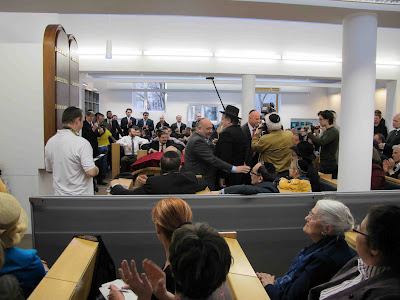 Synagogue on Karoli Gaspar ter. Photo (c) Ruth Ellen Gruber
Synagogue on Karoli Gaspar ter. Photo (c) Ruth Ellen Gruber
This is one of three synagogues in Budapest that have young and growing congregations. Another is the lovely courtyard Frankel Leo synagogue, also in Buda.
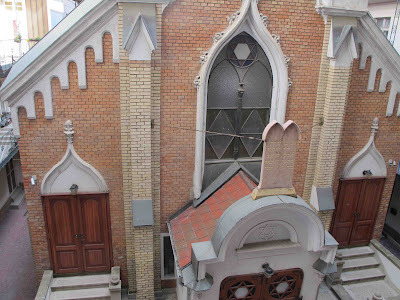 Frankel Leo Synagogue. Photo (c) Ruth Ellen Gruber
Frankel Leo Synagogue. Photo (c) Ruth Ellen Gruber
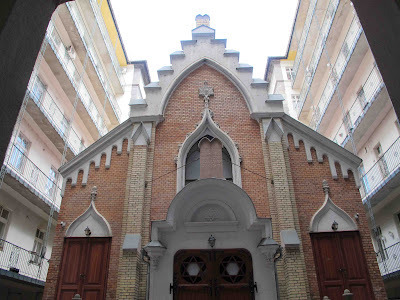 Frankel Leo synagogue. Photo (c) Ruth Ellen Gruber
Frankel Leo synagogue. Photo (c) Ruth Ellen Gruber
It has been a busy visit so far in Budapest, with little time to stop and reflect (or post). Here are a few highlights..... and with luck I'll be able to add a bit more in the coming days. Today at least I managed to stock up on matzo for Passover -- there are several kosher shops now selling kosher for Pesach brands, at a wide variety of prices, I might add. The commercial kosher shops sell it for just about twice the price of what the Jewish-community run outlets do. But that's business....
Let me perhaps tell it in pictures:
Last week I attended the opening of a newly enlarged synagogue -- three times its original size -- in a residential neighborhood in Buda. And then I went there for services. Here's a link to a 360 degree panorama of the place. And my own pic from the opening:
 Synagogue on Karoli Gaspar ter. Photo (c) Ruth Ellen Gruber
Synagogue on Karoli Gaspar ter. Photo (c) Ruth Ellen GruberThis is one of three synagogues in Budapest that have young and growing congregations. Another is the lovely courtyard Frankel Leo synagogue, also in Buda.
 Frankel Leo Synagogue. Photo (c) Ruth Ellen Gruber
Frankel Leo Synagogue. Photo (c) Ruth Ellen Gruber Frankel Leo synagogue. Photo (c) Ruth Ellen Gruber
Frankel Leo synagogue. Photo (c) Ruth Ellen Gruber
Published on April 04, 2012 15:28
March 30, 2012
Moldova -- Fire Damages Ruined Chisinau Synagogue Listed as Historic Monument
By Ruth Ellen Gruber
Here's a cross post from Jewish Heritage Europe -- Claude Cahn, who lives near this synagogue in Chisinau, says he will check the site and provide more information:

Here's a cross post from Jewish Heritage Europe -- Claude Cahn, who lives near this synagogue in Chisinau, says he will check the site and provide more information:
According to a report (including video) on Moldovan TV, fire -- possibly due to arson -- has damaged what had been the already gaping ruins of an early 20th century synagogue, located on Rabbi Tirelson street. The fire was doused within half an hour and the extent of the damage was not clear.
The media quote neighbors as saying the ruined synagogue - which despite its condition was listed as a local historic monument -- had been bought recently by a group of Jews who wanted to rebuilt it.
Published on March 30, 2012 01:39
March 27, 2012
Budapest -- Q6Q7 Jewish District Festival Holds a Spring Edition at Passover
By Ruth Ellen Gruber
For the past few years, Budapest's downtown Jewish Quarter, straddling the 7th and 6th Districts, has been the scene of a Hanukkah festival that takes place in various local clubs, galleries, restaurants, cafes and other venues.
This Spring, the organizers are offering a similar Quarter6Quarter7 festival over Passover, April 6-14.
The program includes both first and second night seders, as well as concerts, dances, films, talks and guided tours of the district.
For the past few years, Budapest's downtown Jewish Quarter, straddling the 7th and 6th Districts, has been the scene of a Hanukkah festival that takes place in various local clubs, galleries, restaurants, cafes and other venues.
This Spring, the organizers are offering a similar Quarter6Quarter7 festival over Passover, April 6-14.
The program includes both first and second night seders, as well as concerts, dances, films, talks and guided tours of the district.
Published on March 27, 2012 13:53
Budapest -- Jewish Heritage Conference
By Ruth Ellen Gruber
I'm taking part in what promises to be a fascinating conference tomorrow and Thursday in Budapest on Jewish Heritage in the Digital Era. Some of the top people in the field in Central Europe will be presenting and the discussion should be interesting. I'll be presenting on the Jewish Heritage Europe web site and how we hope it follows up on the Bratislava meeting held 3 years ago.
Here's the program:

I'm taking part in what promises to be a fascinating conference tomorrow and Thursday in Budapest on Jewish Heritage in the Digital Era. Some of the top people in the field in Central Europe will be presenting and the discussion should be interesting. I'll be presenting on the Jewish Heritage Europe web site and how we hope it follows up on the Bratislava meeting held 3 years ago.
Here's the program:
Program
Jewish Heritage in the Digital Era / Zsidó örökség a digitális korszakban
28. 03. 2012
Jewish Monuments in the Visegrad Countries I. /Zsidó műemlékek a visegrádi országokban I.
Chair: Tamas Paszternak
10:00: Greetings: Gusztáv Zoltai, Director of the Jewish Community of Budapest / Zoltai Gusztáv, a Budapesti Zsidó Hitközség igazgatójának köszöntője
10:30: Key-note: Klein, Rudolf: Synagogues of Hungary / Magyarország zsinagógái
11:30: Coffee–break
11:45: Toronyi, Zsuzsanna: The history of Jewish heritage protection in Hungary / A magyarországi zsidó örökségvédelem története
12:15: Ruth Ellen Gruber: The Bratislava declaration, 2009 / A Pozsonyi nyilatkozat, 2009
13:00: LUNCH / EBÉD
Jewish Monuments in the Visegrad Countries II. /Zsidó műemlékek a visegrádi országokban II.
Chair: Zsuzsanna Toronyi
14:00: Bergman, Eleonora, Poland / Lengyelország
14:30: Borsky, Maros, Slovakia / Szlovákia
15:00: Berankova, Zuzana, Polakovic, Daniel, Czech Republic / Csehország
15:30: Balogh, István, Anna Gabor, Hungary / Magyarország
16:00: Jaroslav Klenovsky, Czech Republic / Csehország
16:30: Laszlo Negyela, Serbia / Szerbia
17:00: Coffee - Questions and Answers / Kérdések és válaszok
18:00: Discussion by walking in the Jewish Quarter: Contemporary questions of the heritage protection, lead by Andrea Deák and Zoltán Nagy, with participation of Anna Perczel / Beszélgetés séta közben a zsidó negyedben: a műemlékvédelem aktuális kérdéseiről. A sétát vezeti Deák Andrea és Nagy Zoltán, Peczel Anna részvételével
18:00: Film-screening: I Can Ghetto! documentary film realized by Istvan Javor / Negyedem, negyeded, Jávor István filmje, Hungarian with English subtitles - link to the film / megnézem
29. 03. 2012
Digitized Heritage / Digitalizált örökség
9:00: Greetings - dr. Péter Feldmájer, President of the Federation of Jewish Communities / dr Feldmájer Péter MAZSIHISZ elnök köszöntője
9:30: Gabor Kadar: DEGOB – Digitized testimonies / A Deportáltakat Gondozó Országos Bizottság digitalizált jegyzőkönyvei
10:00: Anna Szász: Voices of the 20th Century - Digitized oral history resources / A 20. század hangja - digitalizált oral history források
10:30: Edyta Kurek: Judaica Europeana – Digitized heritage / Judaica Europeana - Digitális örökségünk presentation
11.00: Coffee
11:30: Marcel Kenesei: Centropa – Digitized family stories / Centropa - Digitalizált családtörténetek
12:00: Ákos Gordon: Social media in the heritage protection - Közösségi média az örökségvédelemben
12:30: Robert Langh: MOME – Digital interpretations of the heritage / Az örökség mint digitális művészet
13:00: Lunch
Digitization and Restitution
The section is organized by Agnes Peresztegi
14:00: Ágnes Peresztegi: Databases, Provenance Research, Restitution / Adattárak, eredetkutatás és restitúció
14:30: Marc Masurovsky: Creating Databases, Art Objects at the Jeu de Paume, a Case Study / Adattárkészítési esettanulmány: művészeti tárgyak a Jeu de Paume-ban
15:30: Databases Assisting Restitution Efforts – Roundtable discussion (participants: Agnes Peresztegi, Misha Sidenberg, Marc Masurovsky, Gabor Kadar) / Hogyan segítik az adattárak a restitúciós törekvéseket? Kerekasztal-beszélgetés
17:00: Conclusion / Zárszó
Published on March 27, 2012 12:23
March 19, 2012
Slovakia --1966 footage of synagogue & destruction of Bratislava Jewish quarter
By Ruth Ellen Gruber
Thanks to David Kraus, here is some extraordinary footage from Bratislava in 1966, showing the beginning of the destruction of parts of the Old Town, including the historic Jewish quarter, to make way for the construction of the New Bridge. There are some remarkable shots of the twin-towered, Moorish style synagogue before its demolition in the path of the construction.

Thanks to David Kraus, here is some extraordinary footage from Bratislava in 1966, showing the beginning of the destruction of parts of the Old Town, including the historic Jewish quarter, to make way for the construction of the New Bridge. There are some remarkable shots of the twin-towered, Moorish style synagogue before its demolition in the path of the construction.
Published on March 19, 2012 14:50
Jewish Cemetery in Poland Vandalized
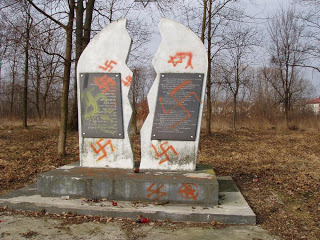
By Ruth Ellen Gruber
Police are investigating a vandal attack on the Jewish cemetery in Wysokie Mazowieckie, Poland, which took place the night of March 18.
Unknown persons spray-painted swastikas and anti-semitic images and slogans, including a favorite slogan of neo-Nazi groups, "Here is Poland -- not Israel.".
The incident is the latest in a series of vandal attacks against Jewish heritage sites in that part of Poland.
Monika Krawczyk, the CEO of FODZ, the Foundation for the Preservation of Jewish Heritage in Poland, notes that FODZ renovated the cemetery in 2006 and regularly maintains it, and the cemetery is enclosed by a fence. But this did not deter the vandals.
You can see a gallery of pictures of the damage provided by Monica on the web site www.jewish-heritage-europe.eu
Published on March 19, 2012 07:43
March 17, 2012
Off Geographical Topic -- historic synagogues being razed in US
By Ruth Ellen Gruber
Every so often I like (or actually dislike) to post news demonstrating how some of the issues regarding what to do with deteriorating or dilapidated synagogues also affect buildings in the United States. Of course, the history is different: the buildings in the US did not lose their congregations because of the Holocaust (or communist pressure) but by normal demographic shifts. Still, there are parallels about preservation versus urban development; funding, memory, and the significance of built heritage.
Two cases in the U.S. are current: the planned demolition of the historic Anshe Kenesseth Israel synagogue building in Chicago, and the threatened demolition of the former Ahavath Sholom synagogue, in Buffalo, NY.
In Chicago, architectural blogger Lee Bey reports that
There is a lengthy article, with pictures, about the Buffalo synagogue on the FixBuffalo blog. Built in 1903, too became a church, Greater New Hope Church of God in Christ, in the 1960s and has stood empty for a decade. The demolition order was issued in December, despite the fact that the building has been designated a local landmark.
Samuel D. Gruber discusses the case of the Buffalo synagogue on his blog.
There is a Flickr feed of photos of the synagogue HERE.
Every so often I like (or actually dislike) to post news demonstrating how some of the issues regarding what to do with deteriorating or dilapidated synagogues also affect buildings in the United States. Of course, the history is different: the buildings in the US did not lose their congregations because of the Holocaust (or communist pressure) but by normal demographic shifts. Still, there are parallels about preservation versus urban development; funding, memory, and the significance of built heritage.
Two cases in the U.S. are current: the planned demolition of the historic Anshe Kenesseth Israel synagogue building in Chicago, and the threatened demolition of the former Ahavath Sholom synagogue, in Buffalo, NY.
In Chicago, architectural blogger Lee Bey reports that
The old Anshe Kenesseth Israel temple, 3411 W. Douglas Blvd, will come down by force of an emergency demolition order issued by a judge last December. Preservationists, neighborhood residents and the building's owners, Abundant Life World Outreach ministry, had been working to delay demolition and develop a fundraising and reuse plan for the building, As recently as last Sunday, they cleaned up the building's exterior in hopes of convincing the city not to raze the structure.The owners changed their mind, he reports, and demolition was expected to begin very soon. The once-grand synagogue was built in 1913, when the neighborhood was largely Jewish. Later, as the neighborhood changed, it became an African-American Baptist church, where Martin Luther King spoke in the 1960s. It closed about a decade ago and has since stood empty. Lee Bey provides vivid photographic documentation that shows its dual history.
There is a lengthy article, with pictures, about the Buffalo synagogue on the FixBuffalo blog. Built in 1903, too became a church, Greater New Hope Church of God in Christ, in the 1960s and has stood empty for a decade. The demolition order was issued in December, despite the fact that the building has been designated a local landmark.
In December, Housing Court Judge Patrick Carney issued an order to demolish the City's oldest synagogue, one of the last remaining vestiges of Jewish life on the City's East Side. The familiar onion domed landmark on Jefferson Avenue was designed by A. E. Minks and Sons and built in 1903. With the cooperation of Rev. Jerome Ferrell and his congregation, the Greater New Hope Church of God in Christ, this historic structure was designated a local landmark by the City's Preservation Board in 1997.
Samuel D. Gruber discusses the case of the Buffalo synagogue on his blog.
The structure is now empty and in disrepair. The building is one of the last standing synagogue of the "facade-dome" type that was popular at the end of the 19th century.
Architecturally, the building is most readily notable for its single 'onion' style dome set over the central entrance bay of the facade. Variations of this type of arrangement are known in synagogue architecture beginning in Europe in the mid-19th century. One example is the destroyed synagogue of Jelgava, Latvia. The style was especially common in Moorish style buildings such as Ahavath Sholom. Major American examples include Temple Sinai in Chicago (Dankmar Adler, arch.) and Temple Beth El in New York (Brunner & Tryon, archs.) which were demolished decades ago. Tiny Gemiluth Chassed in Port Gibson, Mississippi survives. Time may not be long for Buffalo's Ahavath Sholom, but local efforts to save the building may stave off the wrecking ball. [...]
You can read more about the synagogue in this article by Chana Kotzin from the February 10, 2012 issue of the Buffalo Jewish Review. Kotzin runs the Buffalo Jewish archives and has been collecting history about the building, its congregation and the old East Side Jewish neighborhood.
There is a Flickr feed of photos of the synagogue HERE.
Published on March 17, 2012 03:12
March 11, 2012
Czech Republic -- Memorial plaque on former Kutna Hora synagogue
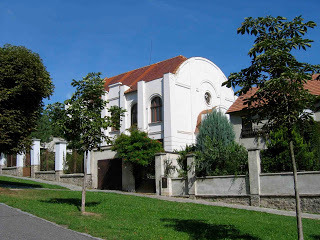 Kutna Hora former synagogue. Photo (c) Ruth Ellen Gruber
Kutna Hora former synagogue. Photo (c) Ruth Ellen GruberBy Ruth Ellen Gruber
A memorial plaque to Holocaust victims has been placed on the former synagogue in Kutna Hora, a charming town an hour's drive east of Prague that is famous for its silver mines and St. Barbara church.
"The plaque was the idea of Mr Marek Lauermann, a young person who is a descendant of a Jewish family that was one of the few from Kutná Hora who partially survived the Holocaust. Marek has long been active in this area, he has released several publications, and he had this memorial plaque designed with our cooperation," Mayor Ivo Šanc said.[...] The Culture to the Town (Kultura do města) association in Kutná Hora has long been involved in preserving the history of the small Jewish community there, which has almost vanished from the memory of its residents. The association organized events as part of the Year of Jewish Culture and published the book "Jews in the Kutná Hora Area - Forgotten Neighbors" (Židé na Kutnohorsku - Zapomenutí sousedé).Read full story
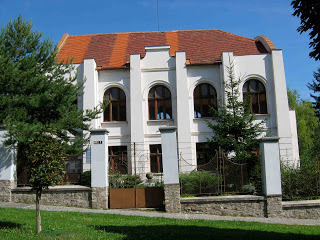 Kutna Hora former synagogue. Photo (c) Ruth Ellen Gruber
Kutna Hora former synagogue. Photo (c) Ruth Ellen GruberJews were barred from living in this mining town from 1568-1848. The surviving synagogue, at ul. Smiskova 619, was built in 1902 in Art Nouveau style. During World War II the Nazis derported the town's Jews to Terezin; few survived. During the war the synagogue was used as a factory making pipe organs. Since 1947 it has been used by the Hussite Church. Most of the decorative elements have been removed.
--
Published on March 11, 2012 03:00
March 10, 2012
Jewish Culture, etc., Festivals in 2012
As usual, I am trying to put together a list of as many as possible of the numerous Jewish festivals -- culture, film, dance, etc -- that take place each year around Europe. I've already missed a few that have taken place this winter --
Please help me by sending me information!
The big culture festivals and other smaller events make good destinations around which to center a trip. Some, like the annual Festival of Jewish Culture in Krakow, are huge events lasting a week or more, which draw thousands of people and offer scores or sometimes hundreds of performances, lectures, concerts, exhibits and the like. Other festivals are much less ambitious. Some are primarily workshops but also feature concerts. Many of the same artists perform at more than one festival.
The list will be growing and growing -- and again, I ask my readers to please send me information and links to upcoming events. Thanks!
ALL OVER EUROPE
Sept. 2, 2012 -- 13th European Day of Jewish Culture. This year's theme is Jewish Humor
CZECH REPUBLIC
July 5-8 -- Boskovice -- UniJazz2012: 19th Festival for the Jewish Quarter
July 30-August 4 -- Trebic -- Trebic Jewish Festival held in one of the most extensive and best-preserved old Jewish quarters in Europe, part of the town's UNESCO-listed historic center.
GERMANY
June 3-16 -- Berlin & Potsdam -- 18th Jewish Film Festival
July 21-August 21 -- Weimar -- Yiddish Summer Weimar
GREAT BRITAIN
June 24-July 1 -- Leeds -- 12th International Jewish Performing Arts Festival
ITALY
April 28-May 1 -- Ferrara -- Festival of the Jewish Book
POLAND
May 13-16 -- Warsaw -- Jewish Book Days
June 29-July 8 -- Krakow -- Jewish Culture Festival
RUSSIA
March 8, 2012 -- Moscow -- Yiddish Fest
---
The big culture festivals and other smaller events make good destinations around which to center a trip. Some, like the annual Festival of Jewish Culture in Krakow, are huge events lasting a week or more, which draw thousands of people and offer scores or sometimes hundreds of performances, lectures, concerts, exhibits and the like. Other festivals are much less ambitious. Some are primarily workshops but also feature concerts. Many of the same artists perform at more than one festival.
The list will be growing and growing -- and again, I ask my readers to please send me information and links to upcoming events. Thanks!
ALL OVER EUROPE
Sept. 2, 2012 -- 13th European Day of Jewish Culture. This year's theme is Jewish Humor
CZECH REPUBLIC
July 5-8 -- Boskovice -- UniJazz2012: 19th Festival for the Jewish Quarter
July 30-August 4 -- Trebic -- Trebic Jewish Festival held in one of the most extensive and best-preserved old Jewish quarters in Europe, part of the town's UNESCO-listed historic center.
GERMANY
June 3-16 -- Berlin & Potsdam -- 18th Jewish Film Festival
July 21-August 21 -- Weimar -- Yiddish Summer Weimar
GREAT BRITAIN
June 24-July 1 -- Leeds -- 12th International Jewish Performing Arts Festival
ITALY
April 28-May 1 -- Ferrara -- Festival of the Jewish Book
POLAND
May 13-16 -- Warsaw -- Jewish Book Days
June 29-July 8 -- Krakow -- Jewish Culture Festival
RUSSIA
March 8, 2012 -- Moscow -- Yiddish Fest
---
Published on March 10, 2012 12:56




